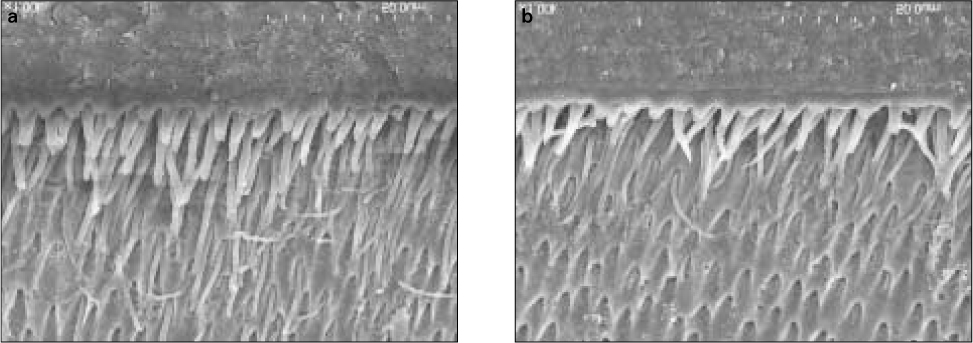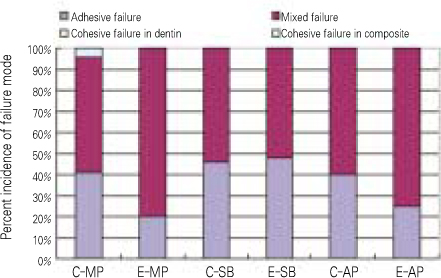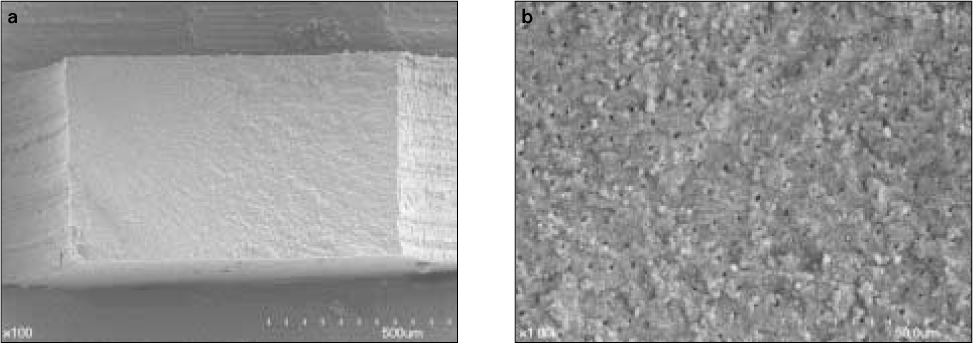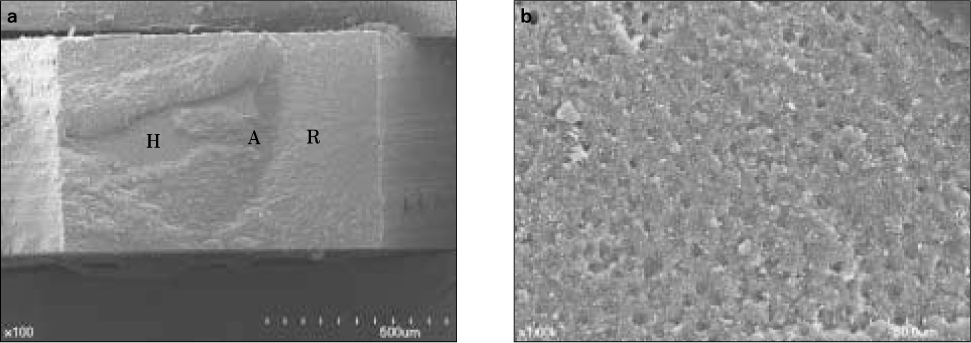J Korean Acad Conserv Dent.
2010 Mar;35(2):125-133. 10.5395/JKACD.2010.35.2.125.
Effect of the exponential curing of composite resin on the microtensile dentin bond strength of adhesives
- Affiliations
-
- 1Department of Conservative Dentistry, School of Dentistry, Seoul National University, Seoul, Korea. chobh@snu.ac.kr
- KMID: 2176300
- DOI: http://doi.org/10.5395/JKACD.2010.35.2.125
Abstract
OBJECTIVES
Rapid polymerization of overlying composite resin causes high polymerization shrinkage stress at the adhesive layer. In order to alleviate the shrinkage stress, increasing the light intensity over the first 5 seconds was suggested as an exponential curing mode by an LED light curing unit (Elipar FreeLight2, 3M ESPE). In this study, the effectiveness of the exponential curing mode on reducing stress was evaluated with measuring microtensile bond strength of three adhesives after the overlying composite resin was polymerized with either continuous or exponential curing mode.
METHODS
Scotchbond Multipurpose Plus (MP, 3M ESPE), Single Bond 2 (SB, 3M ESPE), and Adper Prompt (AP, 3M ESPE) were applied onto the flat occlusal dentin of extracted human molar. The overlying hybrid composite (Denfil, Vericom, Korea) was cured under one of two exposing modes of the curing unit. At 48h from bonding, microtensile bond strength was measured at a crosshead speed of 1.0 mm/min. The fractured surfaces were observed under FE-SEM.
RESULTS
There was no statistically significant difference in the microtensile bond strengths of each adhesive between curing methods (Two-way ANOVA, p > 0.05). The microtensile bond strengths of MP and SB were significantly higher than that of AP (p < 0.05). Mixed failures were observed in most of the fractured surfaces, and differences in the failure mode were not observed among groups.
CONCLUSION
The exponential curing method had no beneficial effect on the microtensile dentin bond strengths of three adhesives compared to continuous curing method.
Keyword
MeSH Terms
Figure
Cited by 1 articles
-
The effect of the strength and wetting characteristics of Bis-GMA/TEGDMA-based adhesives on the bond strength to dentin
Eun-Sook Park, Chang-Keun Kim, Ji-Hyun Bae, Byeong-Hoon Cho
J Korean Acad Conserv Dent. 2011;36(2):139-148. doi: 10.5395/JKACD.2011.36.2.139.
Reference
-
1. Feilzer AJ, de Gee AJ, Davidson CL. Curing contraction of composites and glass-ionomer cements. J Prosthet Dent. 1988. 59:297–300.
Article2. Davidson CL, Feilzer AJ. Polymerization shrinkage and polymerization shrinkage stress in polymer-based restoratives. J Dent. 1997. 25(6):435–440.
Article3. Davidson CL, De Gee AJ, Feilzer A. The competition between the composite-dentin bond strength and the polymerization contraction stress. J Dent Res. 1984. 63(12):1396–1399.
Article4. Feilzer AJ, de Gee AJ, Davidson CL. Setting stress in composite resin in relation to configuration of the restoration. J Dent Res. 1987. 66(11):1636–1639.
Article5. Kemp-Scholte CM, Davidson CL. Marginal integrity related to bond strength and strain capacity of composite resin restorative systems. J Prosthet Dent. 1990. 64:658–664.
Article6. Chye CH, Yap AUJ, Laim YC, Soh MS. Post-gel polymerization shrinkage associated with different light curing regimens. Oper Dent. 2005. 30(4):474–480.7. Davidson CL. Resisting the curing contraction with adhesive composites. J Prosthet Dent. 1986. 55(4):446–447.
Article8. Mehl A, Hickel R, Kunzelmann KH. Physical properties and gap formation of light-cured composites with and without 'softstart-polymerization'. J Dent. 1997. 25(3-4):321–330.
Article9. Uno S, Asmussen E. marginal adaptation of a restorative resin polymerized at reduced rate. Scand J Dent Res. 1991. 99:440–444.
Article10. Sakaguchi RL, Berge HX. Reduced light energy density decreases post-gel contraction while maintaining degree of conversion in composites. J Dent. 1998. 26(8):695–700.
Article11. Unterbrink GL, Muessner R. Influence of light intensity on two restorative systems. J Dent. 1995. 23(3):183–189.
Article12. Oberholpez G, Botha CT, Preez IC. Advances in light curing units and curing techniques : a literature review. SADJ. 2005. 60(10):451–454.13. Suh BI. Controlling and understanding the polymerization shrinkage-induced stresses in light-cured composites. Compend Contin Educ Dent Suppl. 1999. (25):S34–S41.14. Price RBT, Ehrnford L, Andreou P, Felix CA. Comparison of quartz-tungsten-halogen, light-emitting diode, and plasma arc curing lights. J Adhes Dent. 2003. 5:193–207.15. Miyazaki M, Oshida Y, Moore BK, Onose H. Effect of light exposure on fracture toughness and flexural strength of light-cured composites. Dent Mater. 1996. 12(6):328–332.
Article16. Lim MY, Cho KM, Hong CU. Polymerization shrinkage of composite resins cured by variable light intensities. J Korean Acad Conserv Dent. 2007. 32(1):28–36.
Article17. Burgess JO, Walker RS, Porche CJ, rappold AJ. Light curing-an update. Compend Contin Educ Dent. 2002. 23(10):889–906.18. Goracci G, Casa de Martinis L, Mori G. Curing light-intensity and marginal leakage of resin composite restoration. Quintessence Int. 1996. 27:355–362.19. Bouschlicher MR, Rueggeberg FA. Effect of ramped light intensity on polymerization force and conversion in a photoactivated composite. J Esthet Dent. 2000. 12:328–339.
Article20. Deliperi S, Bardwell DN. An alternative method to reduce polymerization shrinkage in direct posterior composite restorations. J Am Dent Assoc. 2002. 133:1387–1398.
Article21. Yap AUJ, Soh MS. Curing efficacy of a new generation high-power LED lamp. Oper Dent. 2005. 30(6):758–763.22. Hofmann N, Hunecke A. Influence of curing methods and matrix type on the marginal seal of class II resin-based composite restorations in vitro. Oper Dent. 2006. 31(1):97–105.
Article23. Koran P, Kurschner R. Effect of sequential versus continuous irradiation of a light-cured resin composite on shrinkage, viscosity, adhesion, and degree of polymerization. Am J Dent. 1998. 11(1):17–22.24. Silikas N, Eliades G, Watts DC. Light intensity effects on resin-composite degree of conversion and shrinkage strain. Dent mater. 2000. 16(4):292–296.
Article25. Friedl KH, Schmalz G, Hiller KA, Markl A. Marginal adaptation of Clss V restorations with and without softstart-polymerization. Oper Dent. 2000. 25(1):26–32.26. Yap AU, Seneviratne C. Influence of light energy density on effectiveness of composite cure. Oper Dent. 2001. 26:460–466.27. Van Meerbeek B, Willems G, Celis JP, Roos JR, Braem M, Lambrechts P, Vanherle G. Assessment by nano-indentation of the hardness and elasticity of the resin-dentin bonding area. J Dent Res. 1993. 72:1434–1442.
Article28. Venz S, Dickens B. Modified surface-active monomers for adhesive bonding to dentin. J Dent Res. 1993. 72:582–586.
Article29. Perdigao J, Ramos J, Lambrechts P. In vitro interfacial relationship between human dentin and one-bottle dental adhesives. Dent Mater. 1997. 13:218–227.
Article30. Choi KK, Condon JR, Ferracane JL. The effects of adhesive thickness on polymerization contraction stress of composite. J Dent Res. 2000. 79:812–817.
Article31. Zheng L, Pereira PNR, Nakajima M, Sano H, Tagami J. Relationship between adhesive thickness and microtensile bond strength. Oper Dent. 2001. 26:97–104.32. Cho BH, Dickens SH. Effects of the acetone content of single solution dentin bonding agents on the adhesive layer thickness and the microtensile bond strength. Dent Mater. 2004. 20:107–115.
Article33. Dickens SH, Cho BH. Interpretation of bond failure through convesion and residual solvent measurements and Weibull analyses of flexural and microtensile bond strengths of bonding agents. Dent Mater. 2005. 21:354–364.
Article34. Scherrer SS, Denry I, Wiskott A, Belser U. Effect of water exposure on the fracture toughness and flexural strength of a dental glass. Dent Mater. 2001. 17:367–371.
Article35. Price RB, Bannerman RA, Rizkalla AS, Hall GC. Effect of stepped vs. continuous light curing exposure on bond strengths to dentin. Am J Dent. 2000. 13:123–128.36. Caldwell R, Kulkarni G, Titley K. Does single versus stepped curing of composite resins affect their shear bond strength? J Can Dent Assoc. 2001. 67(10):588–592.37. Dauvillier BS, Aarnts MP, Feilzer AJ. Developments in shrinkage control of adhesive restoratives. J Esthet Dent. 2000. 12(6):291–299.
Article38. Dennison JB, Yaman P, Seir R, Hamilton JC. Effect of variable light intensity on composite shrinkage. J Prosthet Dent. 2000. 84(5):499–505.
Article39. Park JG, Cho BH, Lee IB, Kwon HC, Um CM. The effects of various light intensity on the polymerization of resin composites. J Korean Acad Conserv Dent. 2001. 26(1):86–94.40. Yun YH, Park SH. The effect of intermittent composite curing on marginal adaptation. J Korean Acad Conserv Dent. 2007. 32(3):248–259.
Article
- Full Text Links
- Actions
-
Cited
- CITED
-
- Close
- Share
- Similar articles
-
- Effect of an intermediate bonding resin and flowable resin on the compatibility of two-step total etching adhesives with a self-curing composite resin
- The influence of cavity configuration on the microtensile bond strength between composite resin and dentin
- The effect of Er,Cr:YSGG irradiation on microtensile bond strength of composite resin restoration
- The effect of bonding resin on bond strength of dual-cure resin cements
- The effect of additional etching and curing mechanism of composite resin on the dentin bond strength





